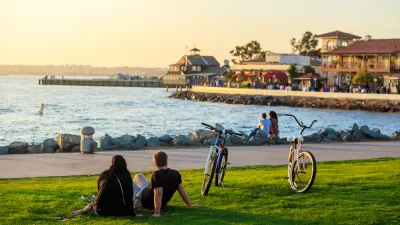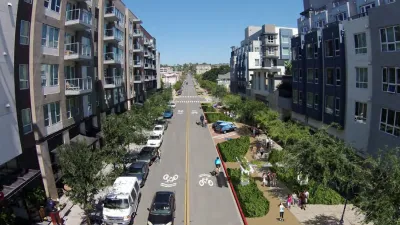The short-term Quartyard pop-up park in San Diego's East Village reflects the changing attitudes of the oft conservative San Diego Planning Department.
As discussed on CityLab by Roxana Popescu, the new Quartyard pop-up park stemmed from an architectural graduate student thesis in 2013 by David Loewenstein, Adam Jubela, Jason Grauten, and Philip Auchettl. Noticing an empty lot catty corner from their school's campus, they envisioned transforming it to a temporary hang-out space from upcycled shipping containers.
To make this dream come to fruition in the fall of 2013 "the team—now called RAD Lab—raised $60,000 through Kickstarter. That money was useful, but proving to the city and investors that San Diegans were excited about the idea was even more valuable, Loewenstein said; the project has since received another $450,000 from a few investors."
As the city has plans to use the empty lot to build a mixed-use development including affordable housing, the project had a quick build, "going from the seed of an idea to groundbreaking in little more than a year, and fittingly, has a short life expectancy. Its lease is for two years, extendable yearly after that."
Bill Fulton, former San Diego planning director, noted how in San Diego there is "a very conservative culture, which is reflected as a cautious approach on the part of the city... I mean culturally conservative, in the sense that... the people that live in San Diego and the power structure are often not at the cutting edge of national trends."
FULL STORY: Selling Conservative San Diego on Experimental Land Uses

Alabama: Trump Terminates Settlements for Black Communities Harmed By Raw Sewage
Trump deemed the landmark civil rights agreement “illegal DEI and environmental justice policy.”

Planetizen Federal Action Tracker
A weekly monitor of how Trump’s orders and actions are impacting planners and planning in America.

The 120 Year Old Tiny Home Villages That Sheltered San Francisco’s Earthquake Refugees
More than a century ago, San Francisco mobilized to house thousands of residents displaced by the 1906 earthquake. Could their strategy offer a model for the present?

LA’s Tree Emergency Goes Beyond Vandalism
After a vandal destroyed dozens of downtown LA trees, Mayor Karen Bass vowed to replace them. Days later, she slashed the city’s tree budget.

Sacramento Leads Nation With Bus-Mounted Bike Lane Enforcement Cameras
The city is the first to use its bus-mounted traffic enforcement system to cite drivers who park or drive in bike lanes.

Seattle Voters Approve Social Housing Referendum
Voters approved a corporate tax to fund the city’s housing authority despite an opposition campaign funded by Amazon and Microsoft.
Urban Design for Planners 1: Software Tools
This six-course series explores essential urban design concepts using open source software and equips planners with the tools they need to participate fully in the urban design process.
Planning for Universal Design
Learn the tools for implementing Universal Design in planning regulations.
Ada County Highway District
Clanton & Associates, Inc.
Jessamine County Fiscal Court
Institute for Housing and Urban Development Studies (IHS)
City of Grandview
Harvard GSD Executive Education
Toledo-Lucas County Plan Commissions
Salt Lake City
NYU Wagner Graduate School of Public Service





























